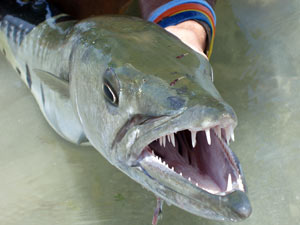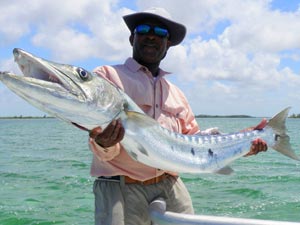
Though the barracuda is not a member of the flat's "Big Three," an elite group consisting of bonefish, tarpon and permit, it undeniably deserves unique status on a shallow water totem extending from Florida's Miami to the Marquesas Keys, as well as the skinny waters of the vast Bahamas.
|
|
| Captain Benry Smith of Andros Island holds up the author's largest flats 'cuda, a 42-pound specimen taken on spinning tackle with 8-pound test line and a tube lure. |
Though the barracuda is not a member of the flat's "Big Three," an elite group consisting of bonefish, tarpon and permit, it undeniably deserves unique status on a shallow water totem extending from Florida's Miami to the Marquesas Keys, as well as the skinny waters of the vast Bahamas.
The foundation for this distinction is embodied by the barracuda's aggression, speed and lunge-jumping way of life, wholly unmatched by any other shallow-water dweller. Simply stated, the 'cuda is the ultimate flats predator.
Consistent with its warrior nature, the 'cuda is very receptive to a wide variety of swiftly retrieved, surface-oriented, commotion lures and flies. More like a shark than a permit or bonefish, the barracuda doesn't "take" a presentation — it attacks it! The barracuda's speed when piling on its prey trumps the striking speed of a tarpon or shark. This has lure-retrieval-strategy implications, which we'll deal with later in the article.
Barracuda on the flats have a size range of 5 to 50 pounds. Florida's state record is 67 pounds and was taken in deeper waters. However, in my 40 years of flats fishing, I can say without exaggeration (having caught fish over 40 pounds) that I have spotted these toothy predators well over 60 pounds. Any shallow-water hunter will appreciate the thrill of battling fish in this size class — fish that also make long-distance runs and jump to heights barely achieved by tarpon.
Habits
Because their predatory nature is best expressed by ambush in the flats and shallows, barracuda have an affinity for hiding along rock piles, wrecks and sea-fan clusters. They are also likely to occur on the outskirts of baitfish schools that traverse the flats, such as mullet, as well as large resident schools of small bonefish. Barracuda are particularly sensitive to the distressed vibrations of injured fish, including hooked small fish; they often attack small hooked bonefish being fought by anglers.
Barracuda have a tendency to inhabit the upper reaches of the water column, but they can hover right off the bottom on the flats. Basically, 'cudas will suspend at whatever level is necessary to attack their prey.
The most unsung (and often unseen) finfish prey of the barracuda is the lowly needlefish, as well as its relative the houndfish. There may be times when anglers poling the flats see needlefish greyhounding madly across the surface of the shallows. Unless these little missiles have baitfish in their jaws, there's a fair chance there's a barracuda right below in mad pursuit. We can thank the pencil shape of the needlefish as the inspirational prototype of the tube lure, which may be the most effective artificial ever devised for flats barracuda.
Casting Tackle
You'll generally spot barracuda finning out in small groups or as large solitary individuals. You may also encounter them by blind casting to likely areas such as rock piles and small wrecks on the top of the tide. Barracuda are most likely to strike when they don't sense anything unusual or threatening -- a poled skiff is both.
 |
| The 'cuda's devastating dentures demand the use of a wire leader. |
The best way to go unnoticed is by making extremely long casts — so long that it might be 15 seconds before the fish notice or "feel" the presence of the skiff. The need for long casts is one of the major determinants of your tackle selection. Nothing beats a stiff graphite spinning rod at least 7' 6" long. Couple this rod with a high quality spinning reel filled with very thin 12-pound braided line, and you'll be able to cast the proverbial "country mile."
The low stretch of braided line transmits the power of the rod (necessary for lure retrieves and hookup sweeps) far better than monofilament. Stated simply, "braid" hooks far-off fish better than mono. Certain lures, such as surface plugs, are better "powered" by braided line for optimal retrieves.
The second determinant of your tackle is retrieval speed, and you should choose a reel capable of a very fast retrieve. Barracuda and other ambush feeders are triggered by the flight of prey. You can rest assured that there is no upper limit to the speed of your retrieve. If you spend the day blind casting to likely areas, a fast-retrieve spinning reel will make your lure speed easier to attain, therefore minimizing the muscle fatigue that's always a risk during any day of fast lure fishing.
You can also use baitcasting reels with a super-fast retrieve ratio, but the small-size diameter of the double-knobbed handle still may not be as comfortable as the larger diameter, single-knobbed spinning reel handle.
Tactics and Baits
There are multiple ways to target barracuda on the flats; casting is only one tactic. Captain Jon Cooper has made a science of pursuing giant 'cuda on the flats by slow-trolling live bait in the shallows with his stealthy electric trolling motor. Jon pilots his shallow draft vessel from the bow with two anglers facing the stern as they slow troll their live mullet baits about fifty yards off the stern.
Jon uses heavy levelwind reels spooled with 40-pound braided line. The business end of his rig features #7 coffee-colored wire rigged with two hooks: a standard J hook through the upper lip of the mullet and a stinger treble hook that trails freely an inch past the baits wagging tail. Mullet seem to be ideal bait, as their tendency is to stay high in the water column — vitally important in such shallow water.
"When I encounter those rare situations when 'cuda are not receptive to lures, I'll often use a live pinfish under a large cork," Jon says. "Generally, the oceanic flats that feature log-sized 'cuda will not hold pinfish, so a quick run to an 'inside flat' may be in order, and all I need is a 'hair hook' and a small piece of shrimp to get this lively bait. If you are far from a pinfish area, there might be some reassurance in knowing that the grunts and snappers that you catch on the oceanic flats edges will work just as well. But be sure to use a large cork float to keep the bait from diving to the bottom. Trophy 'cuda will always respond to the struggling distress of smaller fish — it's simply nature at work!"
 |
| The tube lure may be the most effective artificial ever devised for barracuda on the flats. |
Perhaps the most exciting way to catch barracuda on the flats, however, is by casting lures and flies. As mentioned earlier, spinning and casting reels with a fast-retrieve work beautifully when using tube lures, surface-commotion plugs like the Devil's Horse or walk-the-dog plugs like the Zara Spook. Rig your plugs with a short wire leader to avoid cutoffs and consider replacing the treble hooks with sharp single hooks to avoid unnecessary injury to either fish or angler. And keep in mind the flats maxim that distance casting to undisturbed game fish will increase the likelihood of more strikes.
Most anglers feel comfortable keeping their lure presentations well in front of the fish. Though the barracuda is ferocious, it doesn't expect its prey to land on its head. My advice is to land your artificial about 10 feet in front of the fish or 20 feet beyond the fish. That way there is adequate water to initiate your retrieve and less chance of spooking your quarry.
Though a few flats specialists use a slower retrieve pace, as a general rule of thumb, it's better to keep your lure or plug racing across the surface in keeping with the prey fish you're trying to imitate. Speed coupled with realistic style is the ticket here. Both tube lures and plugs are rigged with treble hooks, and those sharp points are all that's needed for barracuda to hook themselves when they strike.
Anglers using fly tackle will generally need a double-handed stripping retrieve to attain the speed necessary to entice barracuda into striking. This is best done from the bow of a poled boat into a large stripping basket. Not surprisingly, flies for 'cuda are long and have a needlefish profile.
The Finale
When you catch a trophy 'cuda on the flats, you'll probably want a photograph of your catch. It is extremely important when setting up the shot to keep the fish in the water to increase its chance of survival. When the pose has been determined and the photographer is ready, lift the fish out of the water with extreme caution, keeping the head far away from any part of your body — those teeth can inflict a lethal injury!
Though you may have heard barracuda are good eating, it's generally best practice to release these fish and thereby avoid the risk of ciguatera, a foodborne illness caused by eating certain reef fish whose flesh is contaminated with toxins. This is especially the case with specimens over ten pounds.
- 12842 views


